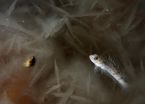(Press-News.org) Boston, MA – Up to 40 percent of patients undergoing breast cancer surgery require additional operations because surgeons may fail to remove all the cancerous tissue in the initial operation. However, researchers at Brigham and Women's Hospital (BWH) have successfully tested a tool they developed that will help surgeons better distinguish cancerous breast tissue from normal tissue, thereby decreasing the chances for repeat operations.
The study is published online the week of September 22, 2014 in the Proceedings of the National Academy of Sciences.
The tool, known as DESI mass spectrometry imaging (or Desorption ElectroSpray Ionization mass spectrometry imaging), works by turning molecules into electrically charged versions of themselves, called ions, so that they can be identified by their mass. By analyzing the mass of the ions, the contents of a tissue sample can then be identified. The tool sprays a microscopic stream of charged solvent onto the tissue surface to gather information about its molecular makeup and produces a color-coded image revealing the nature and concentration of tumor cells.
In this particular case, the researchers used DESI mass spectrometry imaging to look at the distribution and amounts of fatty acid substances, called lipids, within breast tissue and normal tissue from 61 samples obtained from 14 breast cancer patients that underwent mastectomy. A software program was used to characterize the breast cancer tumors and detect boundaries between healthy and cancerous tissue.
The researchers found that several fatty acids, such as oleic acid, were more abundant in breast cancer tissue compared to normal tissue. The results were also confirmed using traditional pathology methods to test for accuracy.
"Our findings demonstrate the feasibility of classifying cancerous and normal breast tissues using DESI mass spectrometry imaging," said Nathalie Agar, PhD, director of the Surgical Molecular Imaging Laboratory, BWH Departments of Neurosurgery and Radiology, senior study author. "The results may help us to move forward in improving this method so that surgeons can use it to rapidly detect residual cancer tissue during breast cancer surgery, hopefully decreasing the need for multiple operations."
Agar, who also is affiliated with the Department of Cancer Biology at Dana-Farber Cancer Institute, notes that the researchers plan to continue to work toward validating the identified biomarkers—the fatty acid substances—to provide tumor margin information during breast cancer surgery. Moreover, BWH plans to use the tool in the near future in its Advanced Multimodality Image Guided Operating (AMIGO) suite, to test its performance in detecting breast cancer margins during patient surgery.
INFORMATION:
This research was funded by the National Institutes of Health Director's New Innovator Award (1DP2OD007383-01), United States Army Medical Research/CIMIT, and National Center for Image Guided Therapy.
Brigham and Women's Hospital (BWH) is a 793-bed nonprofit teaching affiliate of Harvard Medical School and a founding member of Partners HealthCare. BWH has more than 3.5 million annual patient visits, is the largest birthing center in Massachusetts and employs nearly 15,000 people. The Brigham's medical preeminence dates back to 1832, and today that rich history in clinical care is coupled with its national leadership in patient care, quality improvement and patient safety initiatives, and its dedication to research, innovation, community engagement and educating and training the next generation of health care professionals. Through investigation and discovery conducted at its Brigham Research Institute (BRI), BWH is an international leader in basic, clinical and translational research on human diseases, more than 1,000 physician-investigators and renowned biomedical scientists and faculty supported by nearly $650 million in funding. For the last 25 years, BWH ranked second in research funding from the National Institutes of Health (NIH) among independent hospitals. BWH continually pushes the boundaries of medicine, including building on its legacy in transplantation by performing a partial face transplant in 2009 and the nation's first full face transplant in 2011. BWH is also home to major landmark epidemiologic population studies, including the Nurses' and Physicians' Health Studies and the Women's Health Initiative. For more information, resources and to follow us on social media, please visit BWH's online newsroom.
The fine line between breast cancer and normal tissues
Imaging tool may reduce need for repeat breast cancer operations
2014-09-22
ELSE PRESS RELEASES FROM THIS DATE:
Plant variants point the way to improved biofuel production
2014-09-22
Manufacturing biofuels from food crop by-products such as straw could be made quicker and cheaper thanks to the work of scientists in the UK and France.
Researchers funded by the Biotechnology and Biological Sciences Research Council (BBSRC) have discovered variant straw plants whose cell walls are more easily broken down to make biofuels, but which are not significantly smaller or weaker than regular plants.
The discovery could help ease pressure on global food security as biofuels from non-food crops become easier and cheaper to make.
The impact of carbon emissions ...
Study: Antifreeze proteins in Antarctic fishes prevent freezing…and melting
2014-09-22
CHAMPAIGN, Ill. — Antarctic fishes that manufacture their own "antifreeze" proteins to survive in the icy Southern Ocean also suffer an unfortunate side effect, researchers report: The protein-bound ice crystals that accumulate inside their bodies resist melting even when temperatures warm.
The finding is reported in the Proceedings of the National Academy of Sciences.
"We discovered what appears to be an undesirable consequence of the evolution of antifreeze proteins in Antarctic notothenioid fishes," said University of Oregon doctoral student Paul Cziko, who led ...
Healthy lifestyle choices may dramatically reduce risk of heart attack in men
2014-09-22
WASHINGTON (Sept. 22, 2014) — Following a healthy lifestyle, including maintaining a healthy weight and diet, exercise, not smoking and moderating alcohol intake, could prevent four out of five coronary events in men, according to a new study publishing today in the Journal of the American College of Cardiology.
While mortality from heart disease has declined in recent decades, with much of the reduction attributed to medical therapies, the authors said prevention through a healthy lifestyle avoids potential side effects of medication and is more cost effective for population-wide ...
Immune response turned up, not down, by flu during pregnancy, Stanford/Packard study finds
2014-09-22
Pregnant women have an unusually strong immune response to influenza, an unexpected finding that may explain why they get sicker from the flu than other healthy adults, new research from the Stanford University School of Medicine and Lucile Packard Children's Hospital Stanford has found.
The results were surprising because immune responses are thought to be weakened by pregnancy to prevent the woman's body from rejecting her fetus.
The study, which will be published online Sept. 22 in the Proceedings of the National Academy of Sciences, is the first to examine the ...
Firelight talk of the Kalahari Bushmen
2014-09-22
SALT LAKE CITY, Sept. 22, 2014 – After human ancestors controlled fire 400,000 to 1 million years ago, flames not only let them cook food and fend off predators, but also extended their day.
A University of Utah study of Africa's Kalahari Bushmen suggests that stories told over firelight helped human culture and thought evolve by reinforcing social traditions, promoting harmony and equality, and sparking the imagination to envision a broad sense of community, both with distant people and the spirit world.
Researchers previously studied how cooking affected diets and ...
University of Utah engineers unlock potential for faster computing
2014-09-22
SALT LAKE CITY, Sept. 22, 2014 – University of Utah engineers discovered a way to create a special material – a metal layer on top of a silicon semiconductor – that could lead to cost-effective, superfast computers that perform lightning-fast calculations but don't overheat.
This new "topological insulator" behaves like an insulator on the inside but conducts electricity on the outside and may pave the way for quantum computers and fast spintronic devices.
The research, led by University of Utah materials science and engineering professor Feng Liu, was published today ...
Lego-like modular components make building 3-D 'labs-on-a-chip' a snap
2014-09-22
Thanks to new LEGO®-like components developed by researchers at the USC Viterbi School of Engineering, it is now possible to build a 3-D microfluidic system quickly and cheaply by simply snapping together small modules by hand.
Microfluidic systems are used in many fields including engineering, chemistry and biotechnology to precisely manipulate small volumes of fluids for use in applications such as enzymatic or DNA analysis, pathogen detection, clinical diagnostic testing, and synthetic chemistry. Traditionally, microfluidic devices are built in a cleanroom on a two-dimensional ...
Platelets modulate clotting behavior by 'feeling' their surroundings
2014-09-22
Platelets, the tiny cell fragments whose job it is to stop bleeding, are very simple. They don't have a cell nucleus. But they can "feel" the physical environment around them, researchers at Emory and Georgia Tech have discovered.
Platelets respond to surfaces with greater stiffness by increasing their stickiness, the degree to which they "turn on" other platelets and other components of the clotting system, the researchers found.
"Platelets are smarter than we give them credit for, in that they are able to sense the physical characteristics of their environment and ...
Genetic switch regulates a plant's internal clock based on temperature
2014-09-22
Scientists have discovered a key molecular cog in a plant's biological clock – one that modulates the speed of circadian (daily) rhythms based on temperature.
Transcription factors, or genetic switches, drive gene expression in plants based on external stresses – such as light, rain, soil quality, or even animals grazing on them. A team of researchers at USC has isolated one, called FBH1, that reacts to temperature – tweaking the rhythm here and there as needed while in keeping it on a consistent track.
"Temperature helps keep the hands of the biological clock in the ...
Massachusetts General study reveals gene expression patterns in pancreatic CTCs
2014-09-22
Analysis of circulating tumor cells (CTCs) in a mouse model of pancreatic cancer identified distinct patterns of gene expression in several groups of CTCs, including significant differences from the primary tumor that may contribute to the ability to generate metastases. In their study reported in the Sept. 25 issue of Cell Reports, investigators from the Massachusetts General Hospital (MGH) Cancer Center identified several different classes of pancreatic CTCs and found unexpected factors that may prove to be targets for improved treatment of the deadly tumor.
"Our ...
LAST 30 PRESS RELEASES:
A new chapter in quantum vortices: Customizing electron vortex beams
Don’t be a stranger – study finds rekindling old friendships as scary as making new ones
There’s no ‘one size fits all’ when it comes to addressing men’s health issues globally
Comparison of the “late catch-up” phenomenon between BuMA Supreme and XIENCE stents through serial optical coherence tomography at 1–2 month and 2 year follow-ups: A multicenter study
Marine plankton communities changed long before extinctions
Research reveals tools to make STEM degrees more affordable
Q&A: UW research shows neural connection between learning a second language and learning to code
Keane wins 2024 Gopal K. Shenoy Excellence in Beamline Science Award
Livestock abortion surveillance could protect livelihoods and detect emerging global pathogens
Optimal timing maximises Paxlovid benefits for treating COVID-19
IU researchers receive $4.8 million grant to study the role of misfolded protein TDP-43 in neurodegenerative diseases
DOE’s Office of Science Graduate Student Research Program selects 86 outstanding US graduate students
This tiny chip can safeguard user data while enabling efficient computing on a smartphone
World’s chocolate supply threatened by devastating virus
Wake up and die: Human brain neurons re-entering the cell cycle age quickly shift to senescence
Phage therapy is being explored to treat multidrug-resistant bacterial infections, but what are the direct effects of phages on the human host?
Social media use linked to tobacco initiation among youth
Marginalized communities developed 'disaster subculture' when living through extreme climate events, study finds
AGS honors Dr. William Hall with prestigious Nascher/Manning Award in Geriatrics
Human Frontier Science Program: life science research addressing sustainability of living systems
Wind turbine blades get a sustainable upgrade
New study uncovers lasting financial hardship associated with cancer diagnosis for working-age adults in the U.S.
The coupling between healthspan and lifespan in Caenorhabditis depends on…
2 USC faculty members named 2024 Guggenheim Fellows
4 USC faculty members named as fellows of prestigious science organization AAAS
Innovative microscopy demystifies metabolism of Alzheimer’s
Toward unification of turbulence framework – weak-to-strong transition discovered in turbulence
Innovative GREENSKY model elevates UAV efficiency in next-gen wireless networks
Majority of acute care hospitals do not admit representative proportion of Black Medicare patients in their local market
Smoking cessation before laryngeal cancer treatment improves survival, retention of voice box, study shows
[Press-News.org] The fine line between breast cancer and normal tissuesImaging tool may reduce need for repeat breast cancer operations





